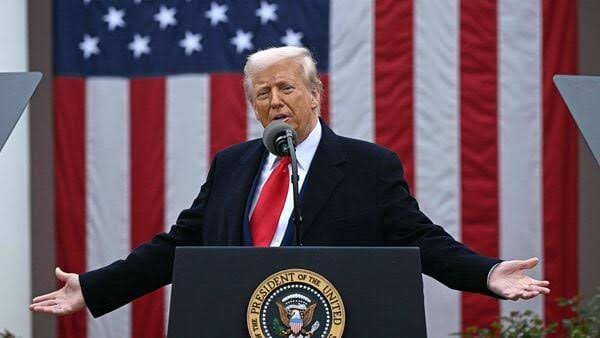37 percent tariff slapped on Bangladesh under new USA trade policy

On April 2, 2025, President Donald Trump unveiled a sweeping new trade policy under the banner of his “Liberation Day” initiative, marking a dramatic shift in the United States’ approach to global trade.
Delivered in a bold and combative speech from the White House Rose Garden, the policy seeks to assert American economic power and correct what Trump claims are decades of unfair trade practices.
The centerpiece of this new policy is the imposition of reciprocal tariffs, which could have far-reaching consequences for nations like Bangladesh, China, and the European Union.
The core of Trump’s new trade policy is reciprocity-if a foreign nation imposes high tariffs or trade barriers on US goods, the US will respond with equally burdensome tariffs on imports from those countries.
In his address, Trump described April 2 as “a day of economic independence,” positioning the tariff measures as a move to end decades of trade imbalances and protect American workers.
According to the president, American businesses and laborers have been “ripped off” by unfair global trade deals, and his plan is intended to rectify these inequities.
The new tariffs, which range from 10 to 50 percent, will be applied on a country-by-country basis, reflecting the trade barriers each nation has imposed on American exports.
For example, the European Union faces a 20 percent tariff, China will be hit with a 34 percent levy, and Japan will be subject to a 24 percent tariff.
However, it is Bangladesh that has drawn particular attention, as the new tariffs are expected to have a significant impact on its economy.
Among the most striking elements of Trump’s proposal is the imposition of a 37 percent tariff on imports from Bangladesh. This decision comes in response to what the US claims is a 74 percent tariff imposed by Bangladesh on American goods, making the 37 percent tariff a retaliatory measure.
The new tariff is a sharp increase from the previous 15 percent rate that was applied to Bangladeshi exports. For Bangladesh, which relies heavily on export-driven growth, particularly in the garment industry, this new tariff represents a severe blow to its economy.
Bangladesh’s garment industry is particularly vulnerable, as it accounts for over 80 percent of the country’s exports to the US. A significant tariff hike could make Bangladeshi garments less competitive in the US market, leading to reduced demand for these products.
Industry leaders in Dhaka have expressed concern that this could lead to job losses and hinder the country’s ability to grow economically amidst rising global competition.
Economists have warned that the new tariffs could destabilize the global garment supply chain, especially given Bangladesh’s position as a key player in the fast fashion industry.
Bangladesh is not alone in facing heavy tariffs under Trump’s new policy. India, another significant trading partner for the US, will face a 26 percent reciprocal tariff, stemming from accusations that India imposes a 52 percent trade barrier on American goods.
Pakistan, too, will be affected by the new tariffs, with the US imposing a 29 percent levy in response to Pakistan’s alleged 58 percent tariff on American imports.
Both countries rely heavily on their textile and garment sectors, and these new tariffs could significantly undermine their ability to compete in the global market.
The impact of Trump’s tariff policy extends beyond South Asia. The European Union will face a 20 percent tariff, signaling a shift in the long-standing trade relationship between the US and Europe.
While this tariff is less severe than those imposed on countries like Bangladesh and China, it could still strain relations between the two economic powers.
The EU has been a key strategic partner for the US, and the new tariffs could exacerbate existing tensions over trade imbalances and regulatory differences.
China, which has been at the center of trade disputes with the US for several years, will face a 34 percent tariff on its goods. This represents an escalation in the ongoing trade war between the two countries, and the Chinese government has already indicated that it will respond with countermeasures of its own.
This could trigger a broader trade conflict, further complicating an already fragile global economic recovery from the COVID-19 pandemic.
While the Trump administration frames these tariffs as necessary to correct trade imbalances and protect American jobs, critics warn that the policy could backfire.
Economists have cautioned that retaliatory tariffs may lead to a trade war that could ultimately increase costs for US businesses and consumers.
Companies that rely on imports from countries like China and Bangladesh for raw materials and finished products may face higher production costs, which could be passed on to American consumers in the form of higher prices.
Small businesses, in particular, could be disproportionately affected by the new tariffs. Retailers and manufacturers who rely on affordable imports may find it more difficult to access the materials and products they need, which could reduce profit margins and undermine their ability to remain competitive in the global market.
Additionally, the broad application of these tariffs could disrupt global supply chains, harming industries that depend on international trade.
Trump’s “Liberation Day” tariffs represent a significant shift in US trade policy, prioritizing reciprocity and taking a hardline stance against perceived unfair practices.
While the policy is framed as a way to protect American workers and industry, the global repercussions remain uncertain.
For Bangladesh and other affected nations, the tariffs could have devastating economic consequences, jeopardizing their ability to compete on the global stage.
The international response to these tariffs will play a crucial role in determining whether Trump’s policy succeeds or leads to a trade war that harms both the US and global economies.
Only time will tell whether the United States’ “Liberation Day” marks the dawn of a new era of protectionism or sparks a broader conflict with far-reaching consequences for the world economy.




